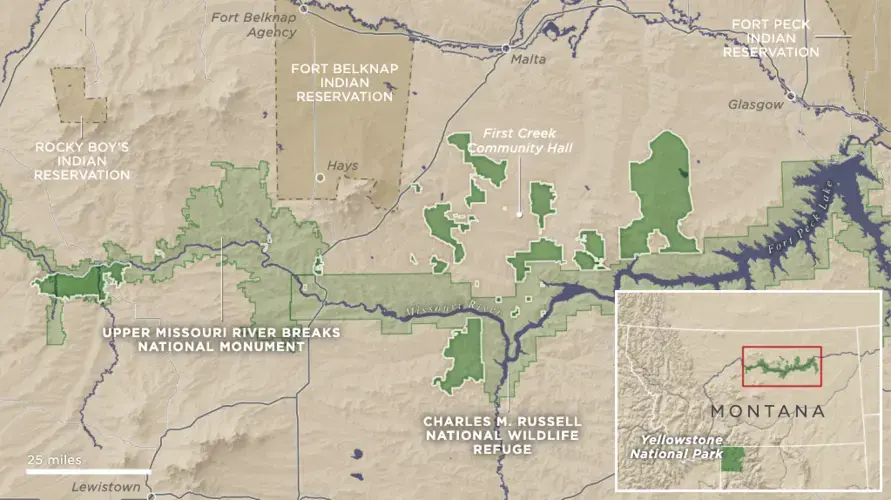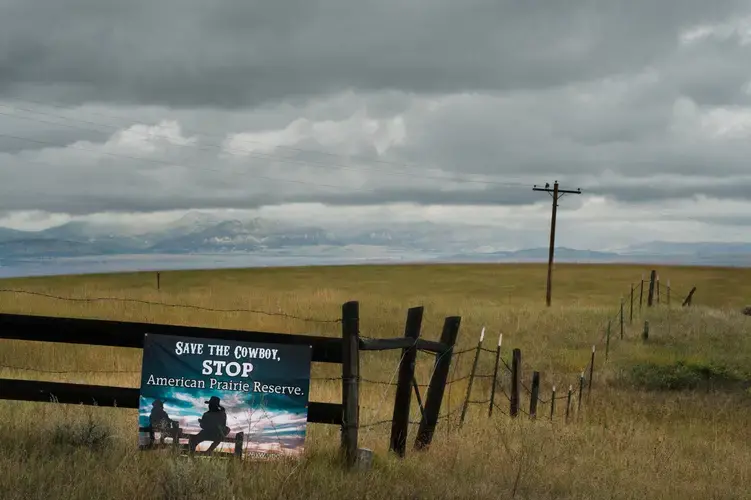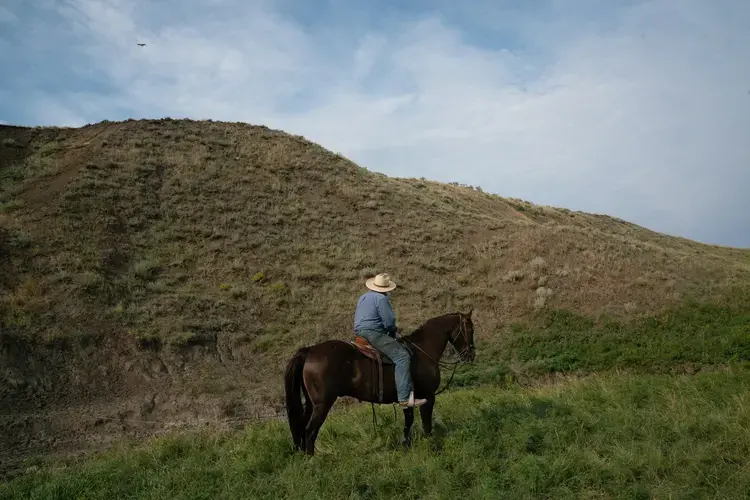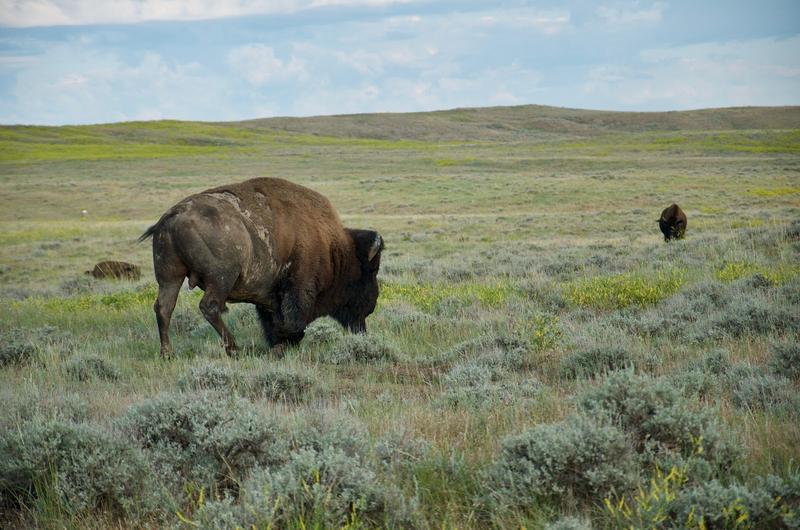
A privately funded, nonprofit organization is creating a 3.2 million-acre wildlife sanctuary — American Prairie Reserve — in northeastern Montana, an area long known as cattle country.
But the reserve is facing fierce opposition from many locals because to build it, the organization is slowly purchasing ranches from willing sellers, phasing out the cows and replacing them with wild bison. Those private properties are then stitched together with vast tracts of neighboring public lands to create one giant, rewilded prairie. The organization has purchased close to 30 properties so far, but it needs at least 50 more.
American Prairie Reserve's Patchwork of Properties

"I see them coming in with big money, buying up ranches and walking over the top of the people who are already here," says ranch owner Conni French. "For them to be successful in their goals, we can't be here, and that's not OK with us."
She isn't alone. Driving around, you see signs everywhere that say, "Save The Cowboy, Stop The American Prairie Reserve."

But the project's efforts have garnered a lot of positive attention from those living outside northeastern Montana because, once it's complete, it will be the largest wildlife sanctuary in the Lower 48 states — about 5,000 square miles, nearly the size of the Serengeti National Park in Tanzania.
A New Kind of National Park
Sean Gerrity, founder of American Prairie Reserve, is standing on one of the vast ranching properties his organization recently purchased. It looks like a miniature Grand Canyon — a panorama of deep, white canyons cut through by a wide, muddy river.
"What you're seeing here is the incredible beauty of the Missouri River out in front of us," he says. "Those beautiful cliffs and the raking light coming across in the afternoon."

The project's goal is to rewild this swath of the Great Plains and return all the animals that lived on this landscape more than a century ago, before white settlers arrived. Wolves, grizzly bears, thousands of genetically pure, wild bison.
Gerrity points down to the valley below. "Over here would be some elk," he says. "Over here would be bison. On the riverbanks would be a mama grizzly bear with two or three little cubs walking along the mud there."
These are animals one would see at Yellowstone National Park, but without so many tourists. The reserve is a new kind of national park, one that's free to the public and privately funded through both small donors and some of the wealthiest people in the world.
American Prairie was founded more than 18 years ago after Gerrity moved back home to Montana from Silicon Valley, where he ran a firm that consulted for companies such as AT&T and Apple. For him, the project promised a different kind of long-term investment.

"To work on something — pour your heart into it — and arrange it like a giant work of art and the public would by and large appreciate and realize it would last far, far beyond my lifetime? That just seemed like a dream come true," Gerrity says.
The reserve has since garnered multimillion-dollar donations from a German billionaire, heirs to the Mars Candy Co., and a handful of top executives in the finance industry, at least two of whom helped steer big investments in oil, gas and coal. Those industries have exacerbated climate change, leading to increased wildfires, floods and drought in the northern Great Plains.

Some see hypocrisy in this kind of money, including Rob Reich, director of the Center on Philanthropy and Civil Society at Stanford University.
"The structure of global capitalism, which they had a role upholding, is partly responsible for the degradation of the environment," Reich says.
But Gerrity says the reserve can't afford to be that picky because almost all of his donors, big and small, are driving the climate crisis.
"The person who puts the gas in their car, or uses the coal in their house to heat, or the person who gets on a nonessential jet trip to take a vacation or go to a wedding or something like that, is the person actually creating the business and encouraging the oil companies to keep on doing what they're doing," Gerrity says.

Besides, he argues, this is one of only a few intact grassland ecosystems in the world and he wants to fully restore it before it disappears.
"This wildlife habitat is going away and there is almost none left," he says. "This is the last bit in the Great Plains, for the most part, where we can do a project of this size."
"The Best Option for Conservation"
Questions about American Prairie's financial support aren't the only issue facing the organization. For the ranching families who have lived and worked in this pocket of northeastern Montana for more than a century, the reserve is an affront.

They make a lot of different arguments against it. Some border on crazy, such as the conspiracy theory that the reserve is part of a cunning plot by the United Nations to clear everyone from the Great Plains. But the most common argument boils down to this: God gave people this land so it can be worked, so we can produce food or fuel from it.
At a community hall that serves as a makeshift church for a small group of ranchers every Sunday, traveling pastor Hal DeBoer says this is a biblical idea.
God placed Adam in the Garden of Eden, "and the very first words that he said to the man was, 'I want you to work this and take care of it.' So to me, that is what the ranchers and farmers are doing. They're working the land, but they're taking care of it."

French, who owns C Lazy J Ranch, is rooted in the Christian notion of stewarding the land and says she will never sell her spread to the reserve.
"We are the best hope to keep this land here," French says. "I really feel like ranchers — these land stewards — are the best option for conservation."
While some ranchers in this pocket of the Great Plains overgrazed their spreads and plowed up native grasses, most did a good job taking care of it. That's a big reason this area is still considered one of the few intact grassland ecosystems in the world. Ranchers here are pretty good stewards.

Powerful conservation groups have taken notice. They are working with some ranchers here to help them save what's left of the prairie while at the same time sustainably raising cattle. But as land prices become more expensive and ranchers struggle to find family members to take over their spreads when they die, their control over northeastern Montana is weakening.
That's a big reason American Prairie is here. There's a lot of land for sale. And as the nation shifts away from its ranching and farming roots, wild places like northeastern Montana are becoming destination spots for hunters, hikers and campers. But French says there's a big difference.
"So then you're a tourist," she says. "You're a visitor. You're an observer. So you're there for a short time and then you go home. When you actually live there, you're a participant. You are involved in the day-to-day life of not just your animals but the land around you."

Still, some locals support American Prairie's plans to build a 3.2 million-acre wildlife reserve here, including hunter Justin Schaaf. He foresees the reserve becoming a sportsman's paradise because, unlike a traditional national park, you can hunt there. He says northeastern Montana's population has been in decline for decades and ranching hasn't stymied the flow. So maybe it's time to try something different.
"Is a little shot of tourism, capitalizing on hunter dollars, bringing more hunters into this area, will that make the difference?" he asks.

Rural recreation counties are growing faster than counties that don't have a lot of hiking, hunting and fishing opportunities, according to the nonprofit Headwaters Economics. Schaaf himself stayed in northeastern Montana because of amenities American Prairie Reserve and other wild places offer.
"I can make more money in other places but it's the outdoors, being able to pull my pickup up here and not talk to anyone and go for a hike all day long, that keeps me here," he says. "Opportunity to just roam, I think, is enticing to young people."

"A Symbol of God"
The project has also garnered support from two local tribal councils, including at the Fort Belknap Indian Reservation, home of the Nakoda and Aaniiih.
At a powwow there, Kenneth Tuffy Helgeson, a member of the Nakoda Tribe, says the reserve's goal of bringing back thousands of wild bison to the plains will help restore a crucial part of his tribe's culture. The animals were nearly eradicated from the prairies by white settlers and the U.S. government more than a century ago. Helgeson recalls his grandfather telling him why the bison were so important to his people.
"The buffalo to the Indian is a symbol of God," he says. "They knew if they took away our main food source — our main symbol of God — that we would be rendered to literally nothing."
But now that symbol of God is coming back to the plains in a big way. American Prairie's wild herd of bison will be the largest in North America. There are already more than 800 on the land.
"It's a reminder of days past," says George Horse Capture Jr., a member of the Aaniiih Tribe. "It's hard to put into words. To me they are a symbol of strength, endurance and the failure — the absolute failure — to go the way of the dodo bird. They were teetering, but now they're back."
Tribes and others are given regulated opportunities to hunt American Prairie's bison. But the land itself will still be owned by white people. Helgeson says that doesn't bother him because land is never really owned.
![George Horse Capture Jr. is a member of the Aaniiih Tribe. 'To me [buffalo] are a symbol of strength, endurance and the failure — the absolute failure — to go the way of the dodo bird,' he says. 'They were teetering, but now they're back.' Image by Claire Harbage / NPR. United States, 2019.](/sites/default/files/styles/height_500/public/_dsc2727_custom-dd086868af0641ffa689075e1b98d297ec5c194d-s1400.jpg.webp?itok=v5_J4xVB)
"In our old songs, our old teachings, there's one song that our people sing. And it says, 'My friend, don't be foolish. The only thing that lives forever is the earth.' "
"We can fight over land, we can fight over dirt, we can fight over all these things," Helgeson continues. "But really all you ever have is what's on your shoes. That's the only dirt that you'll ever own. The only ground that you'll ever own is on your shoes. And that will fall off, too."
With that, Helgeson shakes my hand and walks back to the powwow.
American Prairie's mission to save some of the last grasslands in the world comes with casualties. Whether that's good or bad depends on your story and your relationship with this land.


Education Resource
Behind the Story: A New Kind of National Park
In 2004, an ex-Silicon Valley entrepreneur and his nonprofit, American Prairie Reserve, set out on a...







